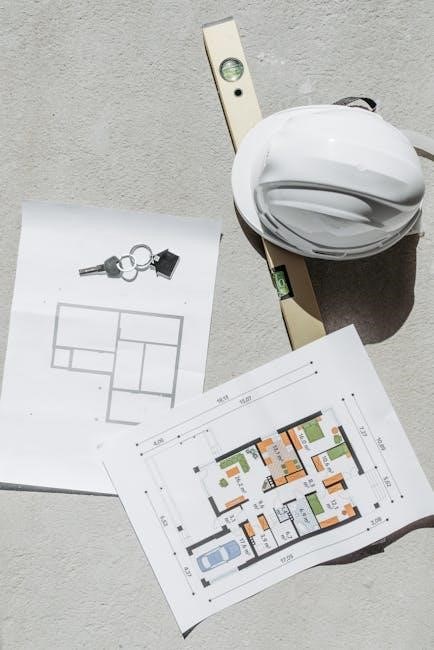Understanding ser and estar is crucial for Spanish grammar. Ser describes permanent traits like jobs or eye color, while estar refers to temporary states or emotions. Worksheets and answer keys offer essential practice;
Understanding the Basics
The distinction between ser and estar is fundamental in Spanish. Ser is used for permanent or inherent characteristics, such as physical traits, jobs, or nationalities (e.g., Soy estudiante ― I am a student). In contrast, estar describes temporary states or emotions (e.g., Estoy feliz ― I am happy). This basic understanding is essential for constructing correct sentences. Worksheets and answer keys provide structured exercises to practice these concepts, helping learners grasp when to use each verb. By focusing on clear examples and explanations, these resources simplify the learning process, ensuring mastery of this critical grammar point.
Importance of Ser and Estar in Spanish Grammar
Mastering ser and estar is fundamental for accurate Spanish communication. These verbs are essential for constructing sentences that express identity, characteristics, and states. Ser and estar help distinguish between permanent traits (e.g., nationality, occupation) and temporary conditions (e.g., emotions, location). Misusing these verbs can lead to misunderstandings, as they convey different meanings. For instance, soy feliz (I am happy) refers to a permanent happiness, while estoy feliz indicates a temporary state. Worksheets and answer keys provide structured exercises to practice these distinctions, ensuring learners grasp their correct usage. This foundation is critical for advancing in Spanish grammar and expressing nuanced ideas effectively.

Differences Between Ser and Estar
Ser describes permanent traits like nationality or occupation, while estar refers to temporary states or emotions. Worksheets clarify these distinctions, aiding learners in understanding through practical examples.
Permanent vs. Temporary Characteristics
In Spanish, ser is used for permanent traits, such as physical appearance or nationality, while estar describes temporary states, like emotions or situations. For example, María es alta uses ser to describe height, a permanent characteristic. Conversely, María está cansada uses estar to express tiredness, a temporary state. Worksheets and exercises help learners master this distinction, with answer keys providing feedback. This understanding is vital for accurate sentence formation. Recognizing whether a characteristic is lasting or fleeting determines verb choice, ensuring clear and correct communication in Spanish.
Physical Traits and Personality
Physical traits and personality are key areas where ser is used. For example, María es alta y delgada describes her height and build. Personality traits like Ella es amable also use ser. Worksheets often include exercises like matching adjectives to correct verbs. Answer keys highlight common mistakes, such as using estar for permanent traits. Practice sheets emphasize that physical and personality descriptions are static, requiring ser. This helps learners avoid mixing ser and estar in such contexts, improving accuracy in describing people and characteristics. Mastering this distinction enhances overall Spanish communication skills.
Occupations and Nationalities
Occupations and nationalities consistently use ser. For example, Él es médico or Ella es abogada describe professions. Nationalities like Ellos son estadounidenses also use ser. Worksheets provide exercises to practice these usages, such as fill-in-the-blank sentences. Answer keys clarify that ser is the correct choice for these contexts. Common mistakes include using estar, but practice helps reinforce the rule. These distinctions are vital for accurate communication in Spanish, ensuring learners can describe who they are and where they come from effectively. Mastering ser for occupations and nationalities builds a solid grammar foundation.
Emotions and Temporary States
Emotions like anger, happiness, or sadness are temporary and use estar. For example, Estoy enojado means “I am angry.” Temporary states, such as La reunión es temporal (“The meeting is temporary”), also use estar. Worksheets emphasize these distinctions, providing sentences like Estoy cansado (“I am tired”) or Está contento (“He is happy”). Answer keys clarify that estar is correct for fleeting feelings or conditions. This helps learners avoid common mistakes, such as using ser for emotions. Practice exercises ensure mastery of these contexts, making it easier to express temporary states accurately in Spanish. Understanding this distinction enhances communication in everyday conversations.

Conjugation of Ser and Estar
Ser and estar have distinct conjugations. Soy, eres, es, somos, sois, son (ser) and estoy, estás, está, estamos, estáis, están (estar) are essential for correct usage in Spanish sentences.
Present Tense Conjugations
The present tense conjugations of ser and estar are essential for Spanish grammar. For ser, the conjugations are:
- Yo soy
- Tú eres
- Él/Ella/Usted es
- Nosotros somos
- Vosotros sois
- Ellos/Ellas/Ustedes son
For estar, the conjugations are:
- Yo estoy
- Tú estás
- Él/Ella/Usted está
- Nosotros estamos
- Vosotros estáis
- Ellos/Ellas/Ustedes están
Mastering these conjugations is crucial for clear and accurate communication in Spanish.
Yo, Tú, Él/Ella/Usted, Nosotros, Vosotros, Ellos/Ellas/Ustedes
Mastering the conjugations of ser and estar for different pronouns is vital. For ser, the forms are:
- Yo soy
- Tú eres
- Él/Ella/Usted es
- Nosotros somos
- Vosotros sois
- Ellos/Ellas/Ustedes son
For estar, the forms are:
- Yo estoy
- Tú estás
- Él/Ella/Usted está
- Nosotros estamos
- Vosotros estáis
- Ellos/Ellas/Ustedes están
These conjugations are fundamental for constructing correct sentences in Spanish.

Examples and Practice Sentences
Practice sentences help clarify the usage of ser and estar. For example, Yo soy estudiante (I am a student) uses ser for a permanent role, while Estoy cansado (I am tired) uses estar for a temporary state. Worksheets provide exercises like filling in the correct verb and identifying contexts, ensuring mastery of their differences.
Using Ser in Context
When using ser in context, it typically describes permanent characteristics, such as physical traits, occupations, or nationalities. For example, Yo soy estudiante (I am a student) uses ser because being a student is a long-term role. Similarly, Él es médico (He is a doctor) describes a permanent profession. Nationalities, like Somos de España (We are from Spain), also use ser. Additionally, ser is used for inherent qualities, such as Ella es alta (She is tall). These examples illustrate how ser is applied to enduring aspects of identity or description, distinguishing it from estar, which is reserved for temporary states. Regular practice with exercises from a ser vs. estar worksheet and answer key PDF can reinforce these distinctions, helping learners master the correct usage of ser in various sentences and contexts.
Using Estar in Context

Estar is used to describe temporary states, emotions, or changing conditions. For example, Estoy en la oficina (I am at the office) indicates a temporary location. Emotions like Estoy enojado (I am angry) are also expressed with estar, as feelings can change. Additionally, estar is used for temporary physical states, such as Está cansado (He is tired); It also applies to situations like La reunión está cancelada (The meeting is canceled), showing a change in plans. Worksheets and answer keys, such as those in a ser vs. estar worksheet and answer key PDF, provide exercises to help learners practice using estar correctly in these contexts, ensuring they understand its application for temporary or fleeting conditions.
Mixed Sentences for Practice
Mixed sentences combine both ser and estar to highlight their differences. For example, She is tall and beautiful (Ella es alta y hermosa) uses ser for permanent traits, while She is happy today (Ella está feliz hoy) uses estar for a temporary emotion. Another example: The book is on the table, and it is open (El libro está sobre la mesa y está abierto), where estar describes its current state. Worksheets often include sentences like Yo soy estudiante, pero ahora estoy cansado (I am a student, but I am tired now), combining permanent and temporary aspects. These exercises help learners practice using both verbs correctly in context, reinforcing their understanding of when to use ser versus estar.

Worksheet and Answer Key
This section provides a downloadable PDF worksheet with exercises to practice ser vs. estar. It includes fill-in-the-blank, multiple-choice, and short-answer questions. The answer key offers correct responses and detailed explanations to help learners master the differences between the two verbs.
Fill-in-the-Blank Exercises

The fill-in-the-blank exercises in the worksheet require students to choose between ser and estar to complete sentences. Each sentence is designed to test understanding of permanent versus temporary characteristics. For example, “María ______ baja” tests physical traits, while “Los estudiantes ______ cansados” assesses temporary states. The exercises cover various contexts like physical descriptions, emotions, and occupations. The answer key provides correct verbs and explanations, ensuring clarity and reinforcing learning. These exercises are ideal for self-study, allowing students to practice and review at their own pace. They also help identify common mistakes, such as confusing permanent traits with temporary conditions.
Multiple Choice Questions

The multiple-choice section offers a variety of sentences where students select the correct verb, ser or estar. Each question focuses on specific contexts, such as emotions, physical traits, or temporary states. For example, “Yo ______ feliz hoy” allows students to choose between soy or estoy. The answer key provides the correct answers and explanations, helping students understand why one verb is appropriate over the other. This format is effective for reinforcing grammar rules and improving decision-making skills. It also identifies areas where students may struggle, such as distinguishing between permanent and temporary states. The questions are designed to cover a range of scenarios, ensuring comprehensive practice.
Short Answer Section
The short answer section challenges students to apply their knowledge by creating sentences using either ser or estar. Prompts include describing a friend’s personality, current emotions, or daily routines. For example, “Write a sentence about your height using ser or estar.” Students must choose the correct verb and conjugate it appropriately. The answer key provides sample responses, such as “Yo soy alto” for height or “Estoy cansado” for tiredness. This section enhances writing skills and reinforces the proper use of these verbs in context. It also allows for creative expression while adhering to grammatical rules.

Answer Key and Explanations
The answer key provides correct solutions for all exercises, ensuring clarity and understanding. Explanations clarify why ser or estar is used, such as “ser for permanent traits” or “estar for temporary states.” For example, in the sentence “La reunión es temporal,” es is correct because it describes a permanent fact. In contrast, “Estoy cansado” uses estar for a temporary condition. The key also highlights common mistakes, like confusing permanent traits with temporary states, and offers tips to avoid them, such as identifying the context and duration of the situation. This section is invaluable for self-study and reinforces learning effectively.

Common Mistakes and Tips
A common error is confusing permanent traits with temporary states. Focus on context and duration to choose correctly. Practice regularly to avoid mixing ser and estar.
Overcoming Confusion Between Ser and Estar
Many Spanish learners struggle with distinguishing ser and estar. A key strategy is to focus on the context and duration of the description. Ser is used for permanent or intrinsic qualities, such as physical traits, nationalities, or professions. For example, María es alta (María is tall) uses ser because height is a permanent characteristic. On the other hand, estar applies to temporary or changing conditions, like emotions or locations. For instance, Estoy cansado (I am tired) uses estar because tiredness is a temporary state. Regular practice with worksheets and answer keys can help solidify this distinction, making it easier to choose the correct verb in various situations.
Mastering the Subtle Differences
Mastery of ser and estar lies in recognizing their subtleties. Ser often describes permanent attributes, such as identity, nationality, or occupation, as in Soy estudiante (I am a student). It also applies to inherent qualities, like La manzana es roja (The apple is red). Conversely, estar captures temporary states or emotions, such as Estoy feliz (I am happy) or El parque está cerrado (The park is closed). Worksheets and answer keys provide structured exercises to refine this understanding, helping learners avoid common mistakes. Continuous practice ensures that these distinctions become second nature, enhancing overall Spanish proficiency. Regular review of these concepts solidifies the correct usage of each verb in various contexts.
Mastering ser and estar is essential for Spanish fluency. Worksheets and answer keys provide practical tools to solidify understanding, ensuring correct usage in both permanent and temporary contexts.
Summarizing Key Points
The distinction between ser and estar is fundamental in Spanish. Ser describes permanent traits, such as physical characteristics, jobs, or nationalities, while estar refers to temporary states, like emotions or conditions. For example, soy estudiante (I am a student) uses ser for a permanent role, whereas estoy cansado (I am tired) uses estar for a temporary state. Worksheets and answer keys provide structured practice, helping learners apply these rules in context. They include exercises like fill-in-the-blank sentences and multiple-choice questions to reinforce understanding. Regular practice with these tools ensures mastery of ser and estar, essential for clear and accurate communication in Spanish.
Encouragement for Further Practice
Mastering ser and estar takes practice, but consistent effort leads to confidence. Use worksheets and answer keys to reinforce your understanding. Start with simple sentences and gradually tackle more complex ones. Practice daily, even if for a few minutes, to build familiarity. Explore online resources, quizzes, and interactive exercises to stay engaged. Speaking with native speakers or joining language groups can also provide real-life context. Celebrate small victories and don’t hesitate to review challenging concepts. With dedication, you’ll navigate ser and estar with ease, enhancing your Spanish communication skills significantly.



